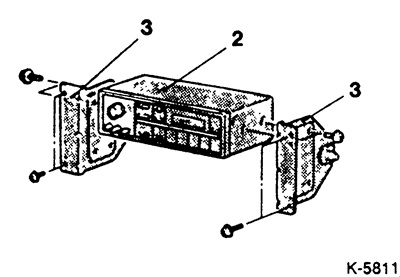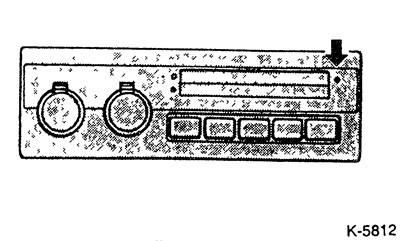Removing the front speaker
Remove the loudspeaker trim from the switch panel, see par. 20.17/20.18.
Release the loudspeaker bracket and disconnect the wire.
Removing the radio
Attention: Radio receivers with code numbers are available for sale. After each installation of the radio receiver, the code must be entered, otherwise the receiver cannot be put into operation; the code number serves as protection against theft of the receiver. If the receiver is coded, you should know the code of the receiver before removing the wires from the battery or before removing the radio. If the receiver code is not known, only the radio manufacturer can put the receiver into operation. The individual code number is usually given in the instruction manual. It must not be stored in a vehicle.
Disconnect the earth cable from the battery.
Attention: This erases data in the electronic memory, such as the engine fault memory or the radio code. Disconnect the battery only when the ignition is off, otherwise the control unit of the fuel injection device may fail. Before disconnecting the battery, read the instructions in section "Removing and installing the battery".
Vehicles up to 8.88: Remove center console, see 20.15.
Vehicles from 9.88: Remove center trim from switch panel, see 20.16.

Give the radio receiver mount and mounting device. Pull out the radio evenly, being careful not to skew.
Disconnect the speaker and antenna connectors, power connector. If the receiver is not connected using standard connectors, mark the wires before disconnecting so as not to mix them up during installation.
Installation
Make the electrical connections on the back of the radio.
Connect ground cable to battery.
Check the functioning of the radio. If the receiver is equipped with a security system, first enter the secret code.
Set the time on the clock.
Instructions for self-installation of the radio receiver.
Attention: If a standard connection cable is not used, make sure that there are no exposed wires. A short circuit can lead to burnt wiring.
Be sure to install tested RFI filters. RFI filters specially designed for MITSUBISHI are commercially available with installation instructions.

Attention: Only for radio receivers with sensor tuning: When installing the radio receiver yourself, match the receiver to the antenna. To do this, fully extend the antenna and turn on full volume. Tune to a frequency of about 1400 kHz, where there is no transmitting station, that is, only noise is heard. By rotating the antenna tuning screw (on the front of the radio trim or on the housing) achieve the maximum volume of noise.
